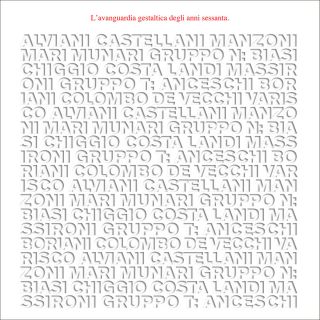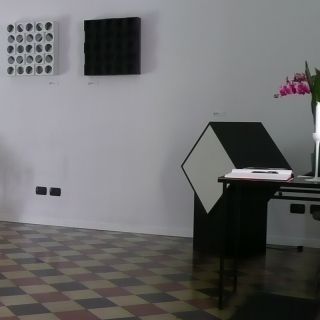Anceschi Giovanni
Giovanni Anceschi was born in Milan on 12 September 1939.
In 1959, together with Boriani, Colombo, and Devecchi, he founded Gruppo T.
He is a Kinetic artist, graphic and multimodal designer, art and design theoretician, essayist, and an organiser of the culture of visibility. For more than fifty years he has been involved in programmed, metamorphic, interactive, and immersive art, as well as information aesthetics.
As a child, he came into contact with such twentieth century writers as Montale, Ungaretti, and Gadda, and had a childhood correspondence with the writer Gianna Manzini.
With regard to the art world, he was very close to Enrico Paolucci (of the Gruppo dei Sei in Turin), who had a house in Rapallo where the Anceschi family went on holiday. He also came to know Giulio Carlo Argan, a guest of Paolucci. Fausto Melotti would drive him to Rapallo in his Millequattro car.
He personally knew Carlo Carrà, the abstractionists Soldati, Radice, Rho and the Concretist group: Gillo Dorfles and, later on, Luigi Veronesi and his sister Giulia.
As an adolescent, in about 1953, he tried out many ways of painting, to arrive at a Post-Cubist/Para-Futurist output, 1955, and then a series of ink works reflecting the work by Crippa, Dova, and Wilfredo Lam.
Finally, having come into contact with Enrico Baj, he began to produce gestural, mixed media, and lyrical abstraction works. Together with Baj he exhibited in the Parisian gallery “Le soleil dans la tête” in December 1958.
His real avantgarde debut, though, was when he published a figurative work, “Marziani fossili”, in Lucio Fontana’s magazine “Gesto interplanetario”, together with works by Enrico Baj and others. The magazine, however, was published only in 1959.
He also knew Manzoni and Castellani. With others from the future Gruppo T, he collaborated on the foundation of the Galleria Azimut.
He enrolled at Milan University where he studied philosophy and followed courses held by Enzo Paci (the course on Husserl’s Cartesian meditations) and by Cesare Musatti (perceptology and psychoanalysis).
At the same time he followed, as “auditor”, the courses by Achille Funi at the Brera Academy, where he came to know Davide Boriani, Gianni Colombo, and Grazia Varisco and, through them, Gabriele Devecchi. While at the decorative design school, the four undertook a large fresco on the amorous metamorphoses of Zeus (Anceschi, who was the smallest and lightest and so could climb higher up, painted the scene of the Eagle for the Ganymede myth). Anceschi became part of this group of artists who organised a show of their work in the Galleria Pater in September 1959, which sparked off the activity and zealous rethinking that was to lead to the birth of Gruppo T.
In the context of the group’s activities, he made works or “effects”, such as, for example, “Quadri clessidra”, 1959, “Tavole di possibilità liquide”, 1959, and “Percorsi fluidi”, helical or rotating “Percorsi fluidi elicoidali”, 1962, and spiral, and cubic ones, 1962. All these led to interactive participation by the public, and explored the possibilities of figural variation produced by chance metamorphoses of the material.
He published two programmed graphics in the 1962 Almanacco Bompiani (in which he explored the perceptive limits of repeatability interference by interweaving, the interference between successive programmes, and the interference of sequences of stimuli), thus anticipating what was to be called Generative Art.
Later on he realised works animated electromechanically: for example, his achrome and trichrome “Structure”,1963, (in which he dealt with the threshold of perception and reception), and his virtual, cylindrical “Strutturazioni”, 1963, (concerned with the perceptive disorientation caused by cyclic and interfering kinetic stimuli).
He inquired into sensorial destabilisation in “Ambiente a chock luminosi”, Paris 1964. These inquiries by Anceschi continued until 1965 as collaborations with, above all, Boriani, to produce “Ambiente stroboscopico”, Eindhoven.
Between 1964 and 1966 he developed, together with Boriani, an extremely important project: “Ambiente per un test di estetica sperimentale”, a scientific inquiry that aimed at measuring aesthetic enjoyment (Zagreb 1965).
His relationship with the group continued until 1968 with his participation in projects organised by Boriani and Colombo.
In the 1970s and at the beginning of the 1980s, Anceschi was close to visual poetry, performances, and readings of the poetry group connected to the “Tam Tam” magazine: Adriano Spatola, Corrado Costa, Giulia Niccolai, and Milli Graffi. The group was involved with the idea of “total poetry”.
In 1974 Anceschi began his “Hyperreadymade” activity, in which he signed sheet from a multiple taken from the “Tavole di possibilità liquide”, made in the United States.
The Hyperreadymade project was presented at “Domus circular”, ideated by Hans Ulrich Obrist and Stefano Boeri, in the San Siro stadium in Milan, on 14 April 2005 and as part of the art seminars organised by the faculty of art and design at IUAV University, Venice, in 2006.
Works in Public Collections:
MACBA, Museo de Arte Contemporaneo, Buenos Aires
Museo del Novecento, Civici Musei di Milano
Fondazione VAF, Francoforte
Museo MART, Rovereto
MAMBO, Galleria d’Arte Moderna di Bologna
Cantiere del ‘900, Collezione Intesa San Paolo, Milano
Museum Ritter, Waldenbuch, Germania
MACBA, Museo de Arte Contemporaneo, Buenos Aires
Museo del Novecento, Civici Musei di Milano
Fondazione VAF, Francoforte
Museo MART, Rovereto
MAMBO, Galleria d’Arte Moderna di Bologna
Cantiere del ‘900, Collezione Intesa San Paolo, Milano
Museum Ritter, Waldenbuch, Germania


 ITALIAN ZERO/CROSS REFERENCE
ITALIAN ZERO/CROSS REFERENCE L'AVANGUARDIA GESTALTICA DEGLI ANNI SESSANTA _ CINQUANT’ANNI DOPO
L'AVANGUARDIA GESTALTICA DEGLI ANNI SESSANTA _ CINQUANT’ANNI DOPO Leggere dagli anni sessanta: Milano
Leggere dagli anni sessanta: Milano Licht und bewegung
Licht und bewegung